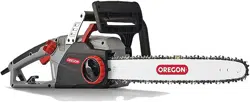Loading ...
Loading ...
Loading ...

21
OPERATING THE CHAIN SAW
OREGON® CHAIN SAW
MODEL CS1500-091
F/N 570773 - AC 0614
BUCKING A LOG
CAUTION: BUCKING LOGS UNDER
TENSION INCREASES THE CHANCE OF
KICKBACK. Use one of the methods below to
support the log when bucking.
Bucking is cutting a log into lengths It is
important to make sure footing is firm and
weight is evenly distributed on both feet
When possible, the log should be raised
and supported by the use of limbs, logs or
chocks
• When the log is supported along its entire
length, cut from the top (overbuck)
(Fig 24)
• When the log is supported on one end,
cut 1/3 the diameter from the underside
(underbuck), then make the finished cut
by overbucking to meet the first cut
(Fig 25)
• When the log is supported on both ends,
cut 1/3 of that diameter from the top
overbuck, then make the finished cut by
underbucking the lower 2/3 to meet the
first cut (Fig 26)
• When bucking on a slope, always stand on
the uphill side of the log (Fig 27)
• To maintain complete control when
cutting through, release the cutting
pressure near the end of the cut without
relaxing the grip on the chain saw handles
• Don’t let the chain contact the ground
• After completing the cut, wait for the saw
chain to stop before you move the chain
saw
• Always stop the motor before moving
from tree to tree
LOG IS SUPPORTED
ALONG ITS ENTIRE LENGTH
CUT FROM TOP (OVERBUCK)
AVOID CUTTING EARTH
FIG. 24
LOG IS SUPPORTED ONE END
1ST CUT UNDERBUCK (1/3 DIAMETER)
TO AVOID SPLINTERING
2ND CUT OVERBUCK (2/3 DIAMETER)
TO MEET 1ST CUT (TO AVOID PINCHING)
FIG. 25
BUCKING A LOG
1ST CUT OVERBUCK (1/3 DIAMETER)
TO AVOID SPLINTERING
2ND CUT UNDERBUCK (2/3 DIAMETER) TO
MEET 1ST CUT (TO AVOID PINCHING)
FIG. 26
BUCKING ON A SLOPE
STAND ON UPHILL SIDE
WHEN CUTTING BECAUSE
LOG MAY ROLL
FIG. 27
Loading ...
Loading ...
Loading ...
